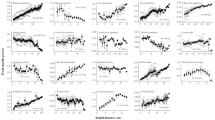Abstract.
In a study of radial trends in specific gravity of ~100 individuals of six mixed-northern-hardwood-forest tree species, three species (Acer rubrum, Pinus strobus, and Betula papyrifera) showed radial increases and three species (Quercus rubrum, Tsuga canadensis, and Fagus grandifolia) radial decreases. Analysis of these data, together with a larger data set including both temperate and tropical tree species, focuses on relationship of radial trends to successional status, variation in inside versus outside wood, and factors affecting degree and direction of radial trend. We propose a model for radial trends in which (1) radial increases associated with low values of specific gravity are an early-successional characteristic and radial decreases associated with high values of specific gravity late successional, (2) the differences in specific gravity and its radial trends reflect growth strategy and biomechanical considerations, and (3) the convergence in values seen in older trees is due to constraints relating to support.
Similar content being viewed by others
Author information
Authors and Affiliations
Additional information
Electronic Publication
Rights and permissions
About this article
Cite this article
Woodcock, .D., Shier, .A. Wood specific gravity and its radial variations: the many ways to make a tree. Trees 16, 437–443 (2002). https://doi.org/10.1007/s00468-002-0173-7
Received:
Accepted:
Issue Date:
DOI: https://doi.org/10.1007/s00468-002-0173-7




